
IMG_3453 / CLF
Marathon race schedule: Late February every year
Time limit: 7 hours
The Tokyo Marathon is a people's marathon with 30,000 participants.
The course is in central Tokyo. The first half is a flat course.
Near the finish there are some ascending hills.
Over 90% of participants finish the run. So, for every 20 runners, almost 19 will finish.
Besides the full marathon there is also a 10km race.
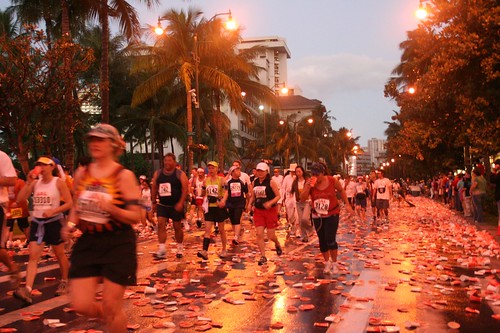
Honolulu Marathon Aid Station / schacon
Marathon race schedule: Early December every year
Time limit: None
Starts in the Ala Moana Park, accompanied by pre-dawn fireworks.
This is recommended as a first marathon because it has no time limit.
Children from age 7 and up can also enter.

observationdeck (23) / the_beekeeper001
Marathon race schedule: Early July every year
Time limit: 7 hours, 10 minutes
A flat course along a beautiful seacoast.
You can experience an exhilarating marathon as the climate is also favorable.
As you view the beach area to your left, you can go for a new record.
A half-marathon and a 5km race are also available.

flora london marathon / shimelle
Marathon race schedule: Mid April every year
Time limit: None
The course begins in Greenwich Park and ends at Buckingham Palace, passing famous places including three World Heritage Sites.
Cushioned shoes are necessary as part of the course is on cobblestones. Lots of cosplay.
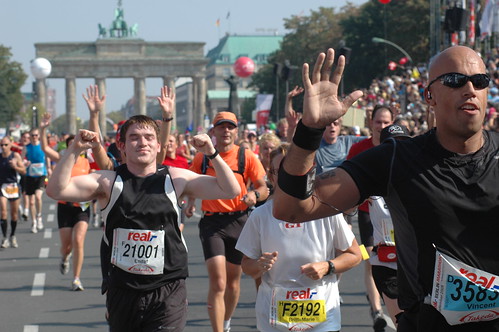
36. Berlin Maratohn / mike.kaden
Marathon race schedule: Late September every year
Time limit: 6 hours, 15 minutes
40,000 runners from over 100 countries run across Berlin in late summer.
The flat course makes for easy record-setting, and the course-side offers lots of support and many spectators.
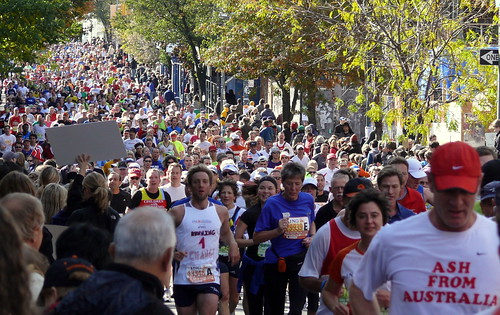
NYC Marathon 08 / the_junes
Marathon race schedule: Early November every year
Time limit: None
The race covers all five boroughs of New York City, finishing in Manhattan's Central Park.
The 2 million spectators pack the course from start to finish without a gap.
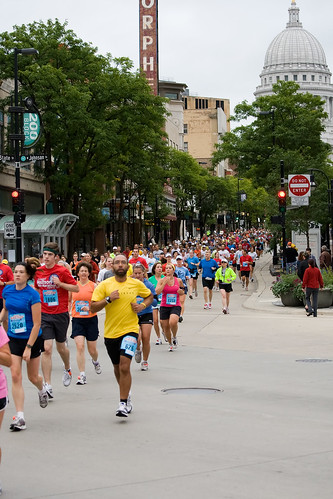
Madison mini marathon / ibm4381
Marathons are held in various places around the world.
From among the world's marathons, here we will introduce marathons in which beginners can easily participate.
To avoid jet lag, don't sleep until nighttime after you arrive.
Go out for a walk instead!

finish line official time 3:09:10 / fergie_lancealot
There are services that will take your photo at the finish line, then sell you the photo from a website. Using such a service allows you to keep good photos of yourself smiling as you cross the finish line.
After finishing, do your stretches, then use ice or spray to ice your muscles. Your next meal should contain sugar and protein.

Stretch it out / lululemon athletica
If you feel pain during a race, stimulate your muscles by skipping or rotating your arms in large circles.
If you think your legs might get cramps, make sure to stretch beforehand.
If you get tired, take a 5 minute break at a water supply point.
If you feel a bit dazed, try switching between breathing through your mouth and breathing through your nose.
If you get blisters, use an adhesive plaster with pads attached to it.

Copenhagen Marathon 2008 / rKistian
When you begin running, discomfort in the chest is caused when your body isn't warmed-up.
Make sure to take the time to warm-up properly.
Pain in your side is caused when your spleen contracts after meals.
Avoid running right after meals and begin running after warming-up.
If you feel pain, slow down your pace and speed up again after your muscles have become warmed-up enough.
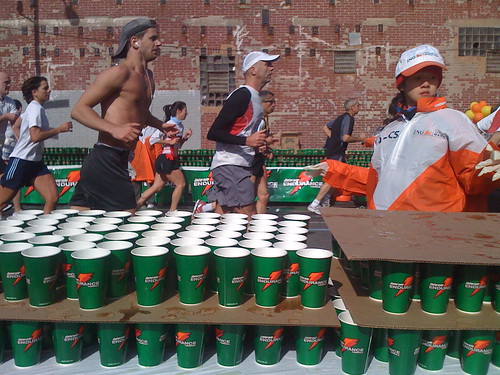
wheres the water? / hsingy
Just after starting, many tend to get excited and go with the flow of other runners.
Don’t rush, and run aiming to increase your pace.
Make sure you drink plenty of water at the water stations.
It's OK to walk when you're drinking.
Drink small sips of water when there are water stations.
Go to the toilet when they are vacant after the half way mark.
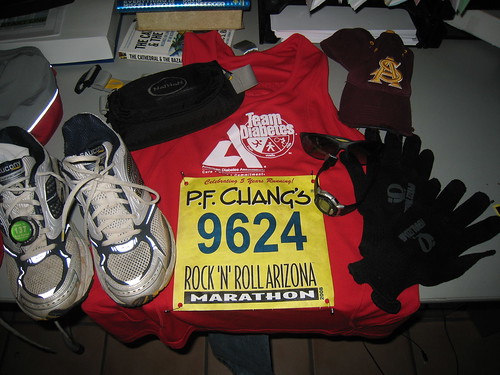
Marathon Gear / cogdogblog
(Getting up) Get up at least four hours before the start of the race.
(Breakfast) Have breakfast at least two hours before the start of the race.
A good choice for breakfast would be power bar, banana and orange juice.
(Arrival) You should aim to arrive at least an hour and a half before the start of the race to be sure you can use the toilet.
Race reception -> Change clothes -> Luggage storage -> Warm-up -> Line up at the start line -> Start.

pasta / Kanko*
Just before the race, be sure to eat plenty of carbohydrates (glycogen) to give you energy.
Eat more than your usual portion of carbs such as rice or pasta.
It's effective to drink something containing citric acid, such as orange juice, with your carbs.
Drink plenty of fluids. Avoid fatty foods, alcohol and caffeine.
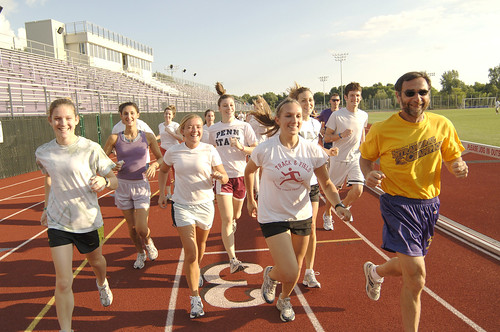
Off to a Running Start / NazarethCollege
This is the schedule starting four weeks prior to the race.
{4 weeks before} Challenge yourself to do the long distance training component of LSD training.
-> {3 weeks before} Run at a pace that feels good, without pushing yourself too far.
-> {2 weeks before} Think of your goal for a finish time and confirm your own pace.
-> {1 week before} It's important not to tire yourself out.
Be careful not to catch a cold!

Marathon de New York : Verrazano Bridge / Martineric
When you can run 30 minutes or more, enter races of 5 to 10km.
Choose races that have flexible time limits.
You can reach the finish line if you run in short-distance races at a slow pace.
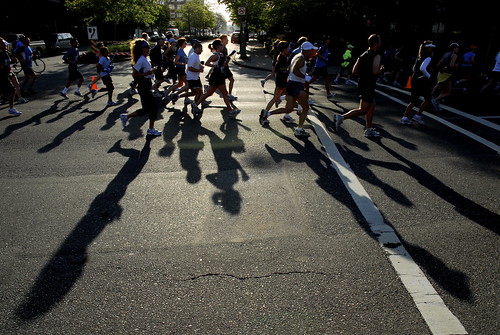
Shadow Runners / thelastminute
Enter your first race.
If you have trained, you can finish 10km.
Here you'll find some advice for race preparations and handling problems during the race.
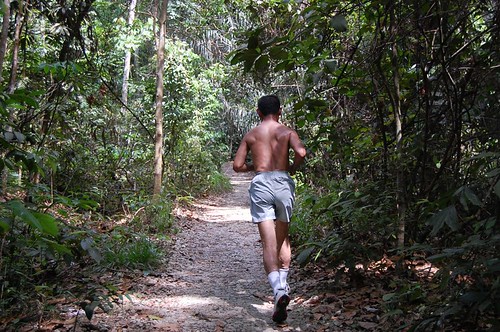
Jogging / kodomut
Trail running is done on unpaved mountain roads.
The training is highly effective, thanks to the up and down hills.
Are you a beginner? Start on a circular unpaved route in a nearby park.
Running in natural surroundings can lift one's mood.
In contrast to an ordinary paved training route, you'll probably notice the unpaved earth feels new and fresh.
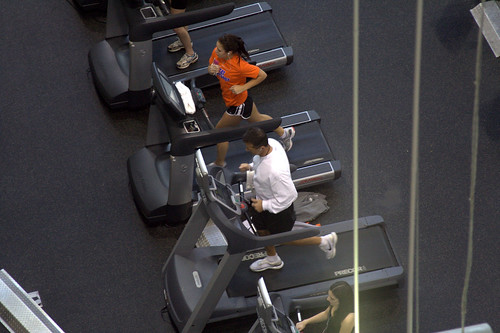
Urban & Nicki Meyer workingout / hectorir
It's an essential piece of gym equipment.
It's a less intense workout compared with outdoor running, so be sure to set an incline of 1-3%.
You can run safely with less of a burden on your knees because of the soft running surface.
Though you may get bored easily due the unchanging environment.
A good way to fight this is to put on some music while you train.

While I was all bundled up:-) / mysza831
Keep warm by wearing a long sleeved shirt, gloves and a hat to cover your entire body.
You can keep yourself warm by coating your body with Vaseline or olive oil to prevent heat loss.
Change into a fresh set of clothes as soon as you finish running to keep yourself from catching a cold.
Take a day off training when the roads are frozen or slippery.
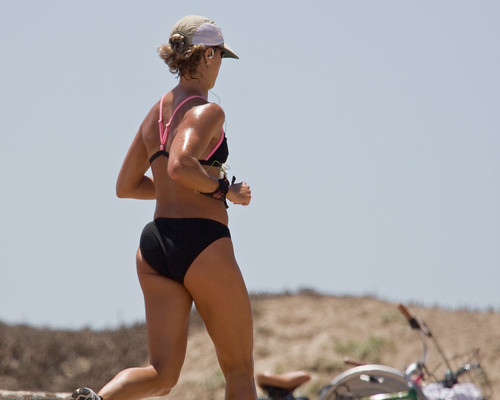
Female jogger with good tan jogging - Scenes from Morro Bay, CA / mikebaird
Choose cool place and time of day to do your running.
Use sweat-absorbing fast-drying training wear and wear a cap during periods of strong sunshine.
Make sure you drink water frequently.
If you feel dizzy or develop a headache, it could be a sign of dehydration. If you experience these symptoms, find a cool spot to rest, lie down and raise your legs.
Wear a windbreaker that is water-repellent or that has a water-proof finish and keep your training limited to a short time.
After training, promptly take a shower to warm your body and make sure to do stretches.
When the rain is really strong, you should avoid training outdoors.
Instead, do muscle training using exercises such as sit-ups, squats, and arm swings using a light dumbbell.

First PFA of 2010 089 / hectorir
There are people who are able to sleep well after moderate training in the evening, while for others, stimulation of the sympathetic nerves makes them unable to sleep.
You should train in a way that fits your own make-up.
Also, you should wear reflective clothing to ensure visibility to passing cars, etc.
Women should avoid running alone as much as possible.
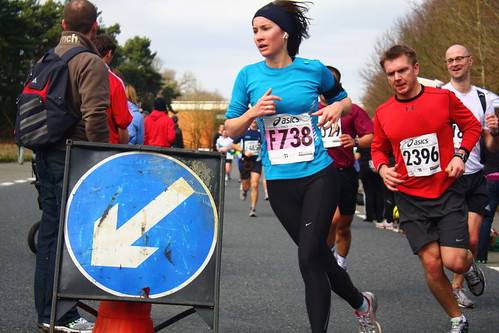
Fleet Half-Marathon 2010 / robertsharp
When you are running and you gradually became short of breath, slow your pace and breathe from your belly.
First, exhale completely.
It is OK if you do not consciously inhale. You can let nature do it.
Occasional belly breathing delivers oxygen to the entire body. You'll run more easily.

DSC03112.1 / zh1yong
"AT" is the boundary between aerobic easy running and anaerobic short distance sprinting.
If you pass your AT level while running, the body cannot absorb enough oxygen, and you gradually weaken.
Beginning runners should keep to a pace below the AT level.
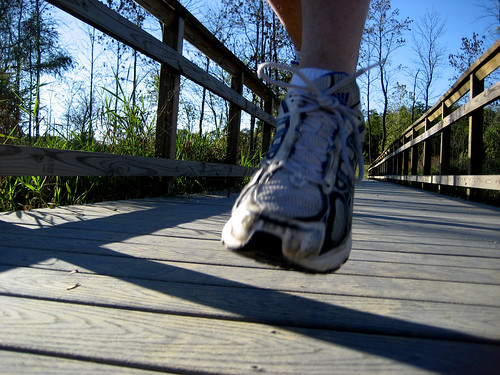
footfall / tangywolf
When running, a force several times the body's weight is exerted on the foot each time it hits the ground.
A heavy body weight can lead to knee or ankle injuries.
If you are heavy, choose well-cushioned shoes, and lose as much weight as possible before beginning a running program.
We recommend you begin by walking.

A morning jog / Vince Alongi
With your home or workplace as a base,
try to setup a few courses such as a course with even elevation, a course with ups and downs,
courses on park lawns or soil and others.
Not only can you avoid getting tired of the same place,
but you can train in a balanced way.

Nike + iPod / dan taylor
Listen to music with a rhythm that fits you and try to control the speed of your running.
BPM means the number of beats per minute.
Beginning runners should choose a song with about 160 BPM, while about 175 BPM is appropriate for advanced runners.
There are also music download sites especially for running.

Jogging along the creek trail / donjd2
Novice runners start out strong but soon run out of breath and start to slow down.
Try to improve this by pacing your running.
Pacing means to keep running for a set distance at a constant speed.
For courses that have distances displayed, try timing yourself and sticking to that time.
If you have just started running, you should aim to complete 1km in 7-8 minutes.

Paris - Luxembourg park Corredora / Celso Flores
LSD stands for 'Long Slow Distance'.
In other words, running long distances at a steady pace.
LSD helps build your cardio-respiratory systems, physical strength and stamina.
Run at a steady pace for one hour, aiming to complete 1km in 7 minutes.
Your pulse rate should be under 120-130 beats per minute.
Run at a pace where you are comfortable speaking with your friends.

Golden girl / Ernst Moeksis
To start, try running for 30 minutes.
{Those who started walking half way through}
10 minutes walking + 10 minutes jogging + 10 minutes walking + 10 minutes jogging.
{Those who were just able to complete their run}
10 minutes walking + 20 minutes jogging + 10 minutes walking + 20 minutes jogging.
{Those who were able to complete their run easily}
10 minutes walking + 40 minutes jogging.
Try and aim to run three times a week.
Good form reduces fatigue and helps prevent accidents.
Besides the points of 1 to 5 above, it is important to acquire a big form.
Try to extend your stride while speed training at around 400m to 1000m.
Large strides require tendon and ankle flexibility.
The thighs absorb shock and provide motive power. Thigh stretches can help avoid accidents.
{Front thigh muscle stretch}
While standing, bend one knee, grasp the toes and draw the foot up to the rear. Change sides, right and left.
{Rear thigh muscle stretch}
Squat down with one leg extended, lean forward. Do right and left sides.
Stretching increases flexibility and softens muscle.
{Achilles tendons and calves}
Hold one knee with both hands, extend the opposite leg to the rear. Change sides.
{Sides and shoulders}
Hold one elbow above the head. Raise that elbow with the other hand. Change sides.
{Joint movements}
Rotate knees, wrists, and ankles in large circles.
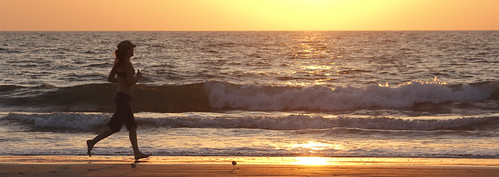
26__MG_0563post / Librex
A training menu to help you run fast, enjoyably, and in beautiful form, plus basic stretches.
Introducing summer training and fitness gym training.

Carolyn, our senior buyer / lululemon athletica
Unlike shoes, there are no limits on running wear.
Anything is OK, as long as it is made of quick-drying material.
The basics are a T-shirt, running shorts, and socks.
When it's cold, you add gloves and a windbreaker.
You can also layer a long-sleeved T-shirt and long tights.
A waist pack is handy for carrying a mobile phone or a water bottle.
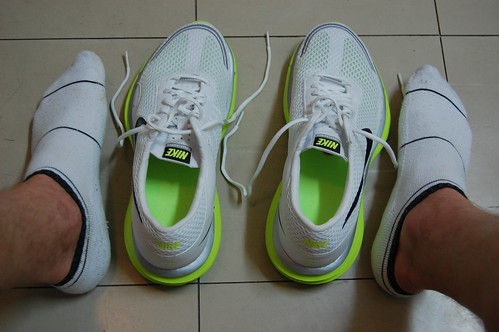
Mans pēdējais cerību stariņš / zilupe
Take the time to loosen the laces when trying on shoes, even though it may be a bother.
After putting on the shoe, tap your heel onto the floor to help it into the heel cup. Once it is held in the heel cup, tighten the laces.
The shoes are OK if the provide 1cm extra room from the toe tips, and if the big and little toes do not hurt.
The shoe width may vary, even in different shoes from the same manufacturer. Therefore, it's best to buy shoes in a specialty shop with a wide selection.
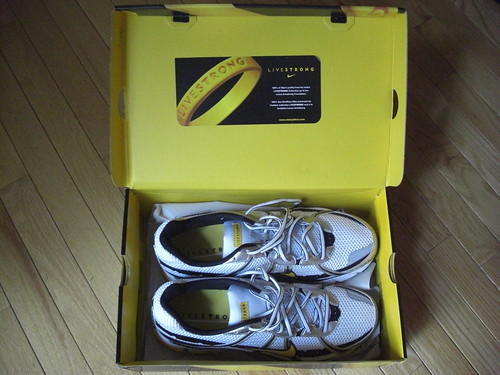
New Nikes to Hit the Jogging Trails / Affiliate
Running is a sport in which shoes are the only required equipment.
For that very reason, shoe selection is key.
Running shoes can be roughly divided into two types: Racing shoes and training shoes.
Beginners should choose training shoes with thick soles and hefty cushions.
This type is also the correct choice for a first race.

female-jogger-morro-bay-coleman-avenue / mikebaird
If you run for 10-15 minutes, your whole body will start to feel lighter.
This feeling is called 'second wind', when the brain releases a hormone called adrenaline.
Adrenaline puts the brain in a state of meditation, which will make you feel relaxed, an effective form of stress relief.
 Jogging along the creek trail / donjd2
Running is a form of aerobic exercise, so taking in oxygen from the air will make your body burn fat.
For each kilogram of body weight, in 1km or running you will burn away 1kcal.
That means that if you weigh 60kg, after running for 1km you will have burned 60kcal.
Jogging along the creek trail / donjd2
Running is a form of aerobic exercise, so taking in oxygen from the air will make your body burn fat.
For each kilogram of body weight, in 1km or running you will burn away 1kcal.
That means that if you weigh 60kg, after running for 1km you will have burned 60kcal.

Walk, Don't Run / vortistic
We thought it would be useful to explain how running helps you lose weight as well as reduce stress levels.
We will also help you choose the right shoes and running wear suitable for any season.







































